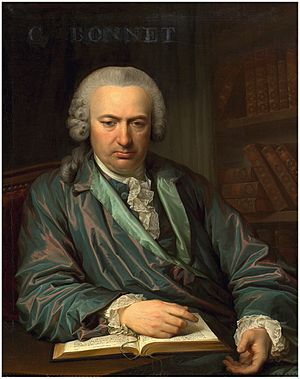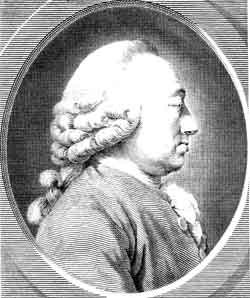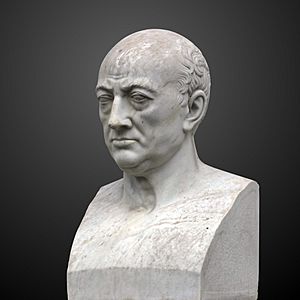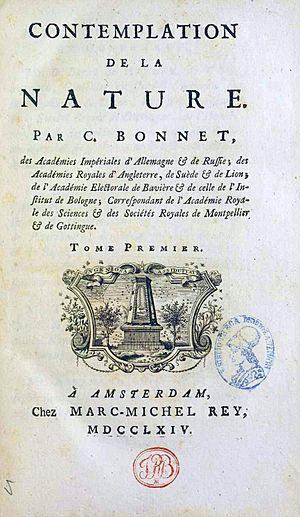Charles Bonnet facts for kids
Quick facts for kids
Charles Bonnet
|
|
|---|---|

Bonnet painted by Jens Juel, 1888.
|
|
| Born | 13 March 1720 |
| Died | 20 May 1793 (aged 73) Genthod near Geneva, Republic of Geneva
|
| Citizenship | Citizen of the Republic of Geneva |
| Scientific career | |
| Fields | Naturalist |
| Influences | Gottfried Wilhelm Leibniz |
Charles Bonnet (born March 13, 1720 – died May 20, 1793) was a famous naturalist and writer from Geneva. He studied nature and philosophy. He was one of the first to use the word "evolution" in biology. He also came up with the term "phyllotaxis" to describe how leaves are arranged on plants.
Bonnet was among the first to notice that aphids (tiny insects) could reproduce without a mate. He also found that insects breathe through small holes called spiracles. He had hearing loss from a young age and later in life, his eyesight also became poor. Because of this, he needed helpers for his research.
Contents
Life and Discoveries
Charles Bonnet was born in Geneva. His family had moved there from France to escape religious persecution. When he was seven, he lost his hearing. This made him very interested in the natural world around him. He was homeschooled because of his hearing difficulty.
Bonnet spent most of his life near Geneva. He was a member of the city's council for a while, but mostly he focused on his studies. He died in 1793 after a long illness. He had no children, but he and his wife raised her nephew, Horace Bénédict de Saussure, who also became a famous scientist.
Early Studies and Insects
Even though he studied law, Bonnet loved natural science the most. When he was 16, he read a book about the ant-lion, which made him want to study insects. He read more books and made his own observations.
In 1740, Bonnet discovered that aphids can reproduce without a male. This is called parthenogenesis. This discovery made him a member of the Academy of Sciences at a very young age. He also studied how hydras (tiny freshwater animals) could regrow lost body parts. In 1742, he found that caterpillars and butterflies breathe through tiny holes called spiracles. In 1743, he became a member of the Royal Society.
Plants and Philosophy
Bonnet published his first book, Traité d'insectologie, in 1745. It contained his discoveries about insects. After this, he became interested in plants, especially their leaves. Even though his eyesight was getting worse, he worked hard.
In 1754, he published Recherches sur l'usage des feuilles dans les plantes. In this book, he noticed that gas bubbles formed on plant leaves underwater. This showed that plants exchange gases. He also suggested that plants might have senses.
As his eyesight worsened, Bonnet turned to philosophy. He wrote books like Essai de psychologie (1754) and Essai analytique sur les facultés de l'âme (1760). These books explored how the mind works.
He also wrote Considerations sur les corps organisées (1762). In this work, he supported the idea that living things develop from tiny, pre-formed "germs."
The Great Chain of Being
One of his most popular books was Contemplation de la nature (1764–1765). In this book, he explained his idea that all living things form a continuous ladder, or "chain of being." This chain goes from the simplest creatures to the most complex, without any gaps. He believed that all beings in nature are connected in a gradual scale.
His last major work was Palingénésie philosophique (1769–1770). In this book, he wrote about the past and future of living beings. He believed that all animals would survive and improve their abilities in a future state. He thought that females carried tiny, miniature versions of all future generations inside them. He also believed that big events like floods could cause living things to change and improve.
Charles Bonnet Syndrome
In 1760, Charles Bonnet described a condition that is now named after him: Charles Bonnet Syndrome. This is when people who are losing their eyesight start to see vivid, detailed things that aren't really there. These are not signs of mental illness. He described this in his 87-year-old grandfather, who was almost blind but saw people, birds, carriages, and buildings. This syndrome mostly affects older people with vision problems, but it can happen to anyone if their brain's vision pathways are affected.
Bonnet's ideas influenced other thinkers who were developing early ideas about evolution.
Works
Books
- Traité d'insectologie (Treatise on Insectology), 1745.
- Recherches sur l'usage des feuilles dans les plantes (Research on the Use of Leaves in Plants), 1754.
- Essai de psychologie (Essay on Psychology), 1754.
- Essai analytique sur les facultés de l'âme (Analytical Essay on the Faculties of the Soul), 1760.
- Considérations sur les corps organisés (Considerations on Organized Bodies), 1762.
- Contemplation de la nature (Contemplation of Nature), 1764.
- La palingénésie philosophique (Philosophical Palingenesis), 1769.
- Œuvres d'histoire naturelle et de philosophie (Works of Natural History and Philosophy), 1779–1783.
- Mémoires autobiographiques (Autobiographical Memoirs), 1948.
See also
 In Spanish: Charles Bonnet para niños
In Spanish: Charles Bonnet para niños







